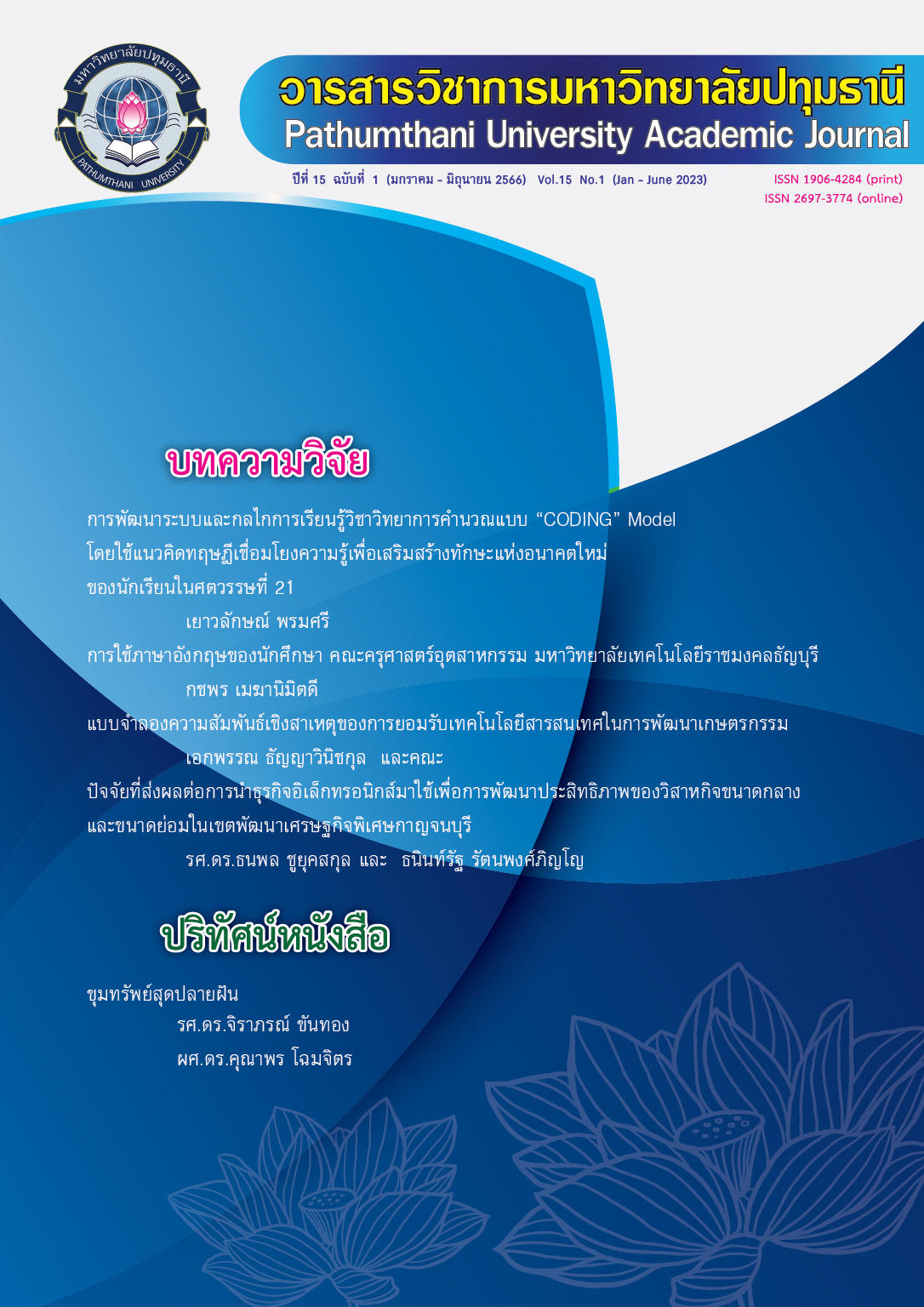“CODING” MODEL: DEVELOPMENT OF SYSTEMS AND LEARNING MECHANISMS BY USING CONNECTIVISM CONCEPT TO ENHANCE THE SKILLS OF THE NEW GENERATION OF STUDENTS IN THE 21ST CENTURY
Keywords:
Learning Activities , Learning Systems and Mechanisms , Skills of The Future in the 21st Century.Abstract
The purpose of this research was to study predictive factors, Systems and Learning Mechanisms in Computational Science with CODING Model by Connectivism Concept to Enhance the Skills of the New Generation of students in the 21st century, using the research and development process. The study population in included teachers and educational personnel. A total of 80 students in Mathayomsuksa 1-3 students were asked to use the mathematical science learning questionnaire, CODING Model, a 5-level estimation scale, 46 items, with content accuracy of .97 and confidence of .99. The data was collected and analyzed with a statistical package. To find the mean standard deviation correlation coefficient and incremental multiple regression analysis or reduce the variable in steps.
The results showed that Learning activities based on the concept of Connectivism in Computational Science. And learning systems and mechanisms for computational science subjects had a statistically significant effect on students' future skills in the 21st century at the .01 by learning activities, learning activities based on the concept of Connectivism, computational science and systems and learning mechanisms for the course of computational science can predict 52.20% together with the forecast equation in raw score form Y=.29+1.64 (learning activities based on the concept of Connectivism in Computational Science) +.70
References
กระทรวงศึกษาธิการ. (2551). หลักสูตรแกนกลางการศึกษาขั้นพื้นฐานพุทธศักราช 2551. กรุงเทพมหานคร : กระทรวงศึกษาธิการ
กิดานันท์ มลิทอง. (2556). เทคโนโลยีการศึกษาและนวัตกรรม. พิมพ์ครั้งที่ 2. กรุงเทพมหานคร : โรงพิมพ์จุฬาลงกรณ์มหาวิทยาลัย.
ข้อมูลฝ่ายวิชาการ. (2564). ข้อมูลนักเรียนประจำปีการศึกษา 2565 ฝ่ายวิชาการ โรงเรียนวัดพิกุลเงิน. องค์การบริหารส่วนจังหวัดนนทบุรี.
ณัฐพร เห็นเจริญเลิศ และคณะ (2559). ขอบแดนใหม่แห่งการเรียนรู้ : การศึกษาระบบ 4.0. กรุงเทพมหานคร : ศูนย์นวัตกรรมการเรียนรู้ จุฬาลงกรณ์มหาวิทยาลัย.
ทิพย์วิมล วังแก้วหิรัญ. (2550). การจัดกระบวนการเรียนรู้. (พิมพ์ครั้งที่ 3). สงขลา : เทมการพิมพ์.
ทิศนา แขมมณี. (2550). รูปแบบการเรียนการสอน. พิมพ์ครั้งที่ 5. กรุงเทพมหานคร : สำนักพิมพ์แห่งจุฬาลงกรณ์มหาวิทยาลัย.
ธงชัย แก้วกิริยา. (2558). การสังเคราะห์รูปแบบแนะนำผู้เรียนอีเลิร์นนิ่งแบบปรับเหมาะตามการวิเคราะห์พหุปัญญาและข้อมูลผู้เรียนที่วิเคราะห์ด้วยเหมืองข้อมูล. กรุงเทพมหานคร : มหาวิทยาลัยเทคโนโลยีพระจอมเกล้าพระนครเหนือ.
บุญชม ศรีสะอาด. (2545). การวิจัยเบื้องต้น. (พิมพ์ครั้งที่ 7). กรงเทพมหานคร : สุวีริยาสาส์น.
วรพจน์ วงศ์กิจรุ่งเรือง และ อธิป จิตตฤกษ์. (2554).ทักษะแห่งอนาคตใหม่ การศึกษาเพื่อ ศตวรรษที่ 21. กรุงเทพมหานคร : open word
วิจารณ์ พานิช. (2555). วิถีสร้างการเรียนรู้เพื่อศิษย์ในศตวรรษที่ 21. กรุงเทพมหานคร : มลูนิธิสดศรีสฤษดิ์วงศ์
สถาบันส่งเสริมการสอนวิทยาศาสตร์และเทคโนโลยี. (2561). หนังสือเรียนรายวิชาพื้นฐานวิทยาศาสตร์ชั้นมัธยมศึกษาปีที่ 1 เล่ม 2 ตามมาตรฐาน การเรียนรู้และตัวชี้วัด กลุ่มสาระการเรียนรู้วิทยาศาสตร์(ฉบับปรับปรุง พ.ศ. 2560). กรุงเทพมหานคร : โรงพิมพ์ สกสค.
สำนักงานเลขาธิการสภาการศึกษา. (2560). รายงานการวิจัยแนวทางการพัฒนาการศึกษาไทยกับ การเตรียมความพร้อมศตวรรษที่ 21. กรุงเทพมหานคร : สำนักงานเลขาธิการสภาการศึกษา.
สำนักเทคโนโลยีเพื่อการเรียนการสอน สำนักงานคณะกรรมการการศึกษาขั้นพื้นฐาน. (2555). คู่มืออบรมปฏิบัติการบูรณาการบูรณาการใช้คอมพิวเตอร์พกพา (Tablet) เพื่อยกระดับการเรียนการสอน. กรุงเทพมหานคร : สำนักเทคโนโลยีเพื่อการเรียนการสอน. สำนักงานคณะกรรมการการศึกษาขั้นพื้นฐาน.
สุทธิวรรณ ตันติรจนาวงศ์. (2560). “ทิศทางการจัดการศึกษาในศตวรรษที่ 21”. วารสารสาขา มนุษยศาสตร์สังคมศาสตร์และศิลปะ มหาวิทยาลัยศิลปากร. ปีที่ 10 ฉบับที่ 2 (พฤษภาคม – สิงหาคม) หน้า 2843 – 2853.
Bednar, A., Cunningham, D. J., Duffy, T., & Perry, D. (1995). Theory in practice: How do we link? In G. Anglin (Ed.), Instructional technology: Past, present, and future. (2nd ed). Englewood, CO: Libraries Unlimited
Bednar, A.K., Cunningham, D., Duffy, T.M., and Perry, J.D. (1991). Theory into practice: How do we link? In G. Anglin (Ed.), Instructional Technology: Past, Present and Future. Englewood, CO: Libraries Unlimited, Inc.
Bloom, B.S. (1966). Taxonomy of educational objectives handbook 1: Cognitive. New York: David McKay.
Bruner, Jerome S. (1965). Studies in Cognitive Growth: Collaboration at the Center for Cognitive Studies. New York: John Wily and Sons.
Gagne, R. (1985). The Conditions of Learning (4th ed.). New York: Holt, Rinehart & Winston.
George Siemens. (2004). Connectivism: A Learning Theory for the Digital Age. from http://www.elearnspace.org/Articles/ Connectivism htm
Guilford, J. P. (1967). Creativity and Its Cultivation. New York: Harper & Brothers.
Guilford, J.p. (1967). The nature of human intelligence. N.Y.; McGraw-Hill Book Company.
Hannafin, M.J., Land, & Oliver,K. (1999). Open learning environments: Foundations, methods, and models. Charles M.Reigeluth (Ed). Instructional design theories and models: A new paradigm of instructional theory. Volume II. London: Lawrence Erlbaum Associates.
Hartman, Hope J. (2002). “Scaffolding and Cooperative Learning.” In H. Hartman (ed.), Human Learning and Instruction (pp. 23-69). New York: City University of New York.
Jonassen, D. (1991). Evaluating Constructivist Learning. Educational Technology, 36(9),28-33.
Maytwin P. (2560) . 21st Century Skill.[Online]. From: https://medium.com/base-the-business-playhouse/21st-century-skill898985d417ce.
Novak J. D. & Gowin D. B. (1980), Learning How to Learn. New York: Cambridge University Press.
Peter E. Doolittle. (2002). Multimedia learning: Empirical Results and Practical Applications. The proceeding of the lrish Educational Technology Users’ Conference.
Sternberg, Robert, J. and William, Wendy, M. (1996). How to Develop Student Creativity. Ebrary Academic Complete Subscription Collection. Alexandria, VA.: Association for Supervision and Curriculum Development.
Torrance, E. Paul. (1962). Guiding Creative Talent. New Jersey: Prentice Hall.
Wallach, M.A. & N. Kogan. (1965). Modes of Thinking in Young Children: A Study of the Creativity-Intelligence Distinction. New York: Holt, Rinehart and Winston.
World Economic Forum. (2016). The Global Information Technology Report 2015 - 2016. [Online]. From: http://www.weforum.org/docs/WEFGITR2015.pdf.
Downloads
Published
How to Cite
Issue
Section
License
Copyright (c) 2023 ํYaowaluk Promsri

This work is licensed under a Creative Commons Attribution-NonCommercial-NoDerivatives 4.0 International License.
บทความที่ได้รับการตีพิมพ์เป็นลิขสิทธิ์ของวารสารมหาวิทยาลัยปทุมธานี
ข้อความที่ปรากฎในบทความแต่ละเรื่อง เป็นความคิดเห็นส่วนตัวของผู้เขียน กองบรรณาธิการไม่จำเป็นต้องเห็นด้วยเสมอไป และไม่มีส่วนรับผิดชอบใด ๆ ถือเป็นความรับผิดชอบของผู้เขียนแต่เพียงผู้เดียว



